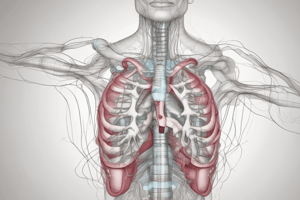Podcast
Questions and Answers
What is the main function of the respiratory system?
What is the main function of the respiratory system?
To ensure the body's continuous supply of oxygen and removal of carbon dioxide.
Describe the components of the respiratory system.
Describe the components of the respiratory system.
The respiratory system consists of airways (nose, mouth, trachea, bronchi, bronchioles) and alveoli (tiny air sacs in the lungs).
What is the process by which air enters the respiratory system called?
What is the process by which air enters the respiratory system called?
Ventilation.
Where does the diffusion of oxygen into the bloodstream occur in the respiratory system?
Where does the diffusion of oxygen into the bloodstream occur in the respiratory system?
What muscle plays a key role in creating negative pressure in the lungs during inhalation?
What muscle plays a key role in creating negative pressure in the lungs during inhalation?
What physiological adjustments occur in the respiratory system during exercise?
What physiological adjustments occur in the respiratory system during exercise?
How does the body's respiratory rate change during sleep?
How does the body's respiratory rate change during sleep?
Name three respiratory disorders or diseases mentioned in the text.
Name three respiratory disorders or diseases mentioned in the text.
What are some exciting areas of contemporary research in respiratory physiology?
What are some exciting areas of contemporary research in respiratory physiology?
Why is understanding the anatomy, physiology, and pathophysiology of the respiratory system crucial?
Why is understanding the anatomy, physiology, and pathophysiology of the respiratory system crucial?
Flashcards are hidden until you start studying
Study Notes
The Respiratory System: A Fascinating Aspect of Human Physiology
The human body is a complex, interconnected network of systems that maintain life. One of these systems, the respiratory system, serves a vital role in ensuring the body's continuous supply of oxygen and removal of carbon dioxide, both essential for cellular metabolism and proper functioning.
The Respiratory System's Components
The respiratory system consists of two main parts:
- Airways: Beginning at the nose and mouth, they extend to the trachea, bronchi, and bronchioles, which are fine tubes within the lungs responsible for delivering fresh air to the alveoli.
- Alveoli: These are tiny air sacs within the lungs where oxygen enters the bloodstream, and carbon dioxide diffuses out via the capillaries surrounding the alveoli.
How the Respiratory System Works
In a process called ventilation, the diaphragm and external intercostal muscles contract and relax to create negative pressure within the lungs, drawing air into the respiratory system. Air then travels through the nose or mouth, down the trachea, into the bronchi, and finally into the bronchioles. The bronchioles branch into increasingly smaller structures called terminal bronchioles that lead to clusters of alveoli.
Oxygen from the inhaled air diffuses across the alveolar membrane and into the bloodstream, which is carried to cells throughout the body. Meanwhile, carbon dioxide produced by cellular metabolism diffuses from the bloodstream into the alveoli, and is exhaled from the body.
Physiological Adaptations and Adjustments
The respiratory system is subject to various physiological adjustments to accommodate different conditions. For example, the respiratory rate and depth increase during exercise to meet the body's increased oxygen demand. Conversely, the body's metabolic rate slows down during sleep, leading to a decrease in respiratory rate.
Respiratory Disorders and Diseases
Malfunctions or damage to the respiratory system can lead to a range of disorders and diseases, such as asthma, chronic obstructive pulmonary disease (COPD), and pneumonia. These conditions can have a significant impact on an individual's quality of life, and proper treatment is essential to reduce symptoms and avoid complications.
Research Advances in Respiratory Physiology
Contemporary research in respiratory physiology covers a wide range of topics, from the cellular and molecular mechanisms of respiration to the development of new treatments and diagnostic tools for respiratory disorders. Some of the exciting areas of research include:
- The role of the autonomic nervous system in regulating respiratory function
- The effects of pollution and environmental factors on respiratory health
- The development of non-invasive diagnostic tools for respiratory diseases
- The use of computational modeling to study respiratory physiology
Conclusion
The respiratory system is a fascinating aspect of human physiology, essential for maintaining life. Understanding the respiratory system's anatomy, physiology, and pathophysiology is crucial for preventing and treating respiratory disorders and diseases. Continued research in this area aims to improve our understanding of respiratory physiology and develop new treatments for respiratory conditions, ultimately enhancing human health and well-being.
Studying That Suits You
Use AI to generate personalized quizzes and flashcards to suit your learning preferences.




